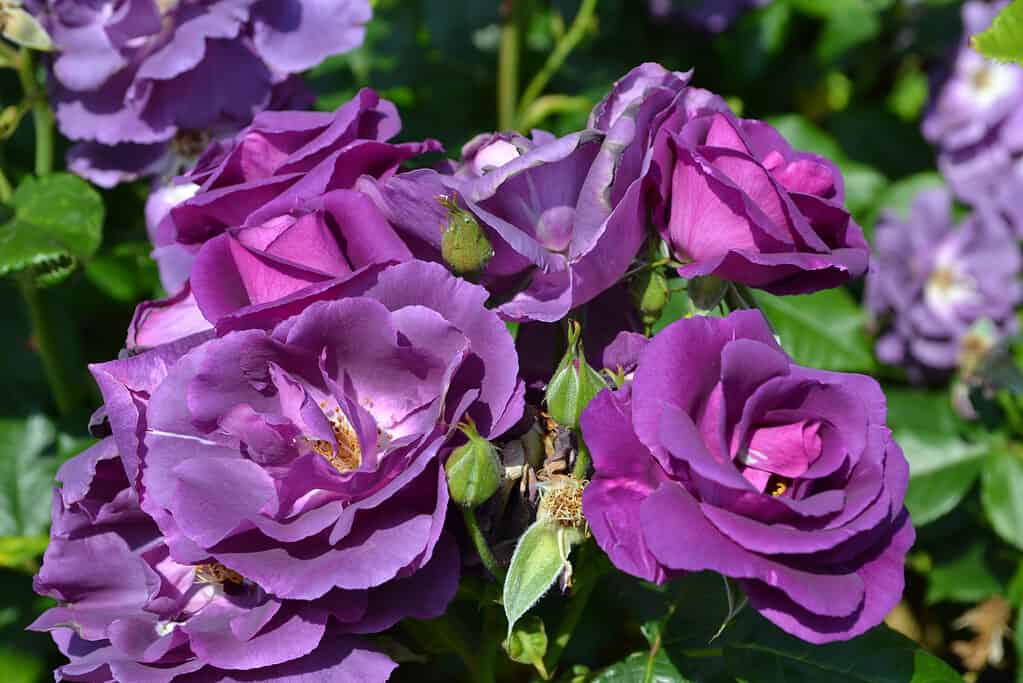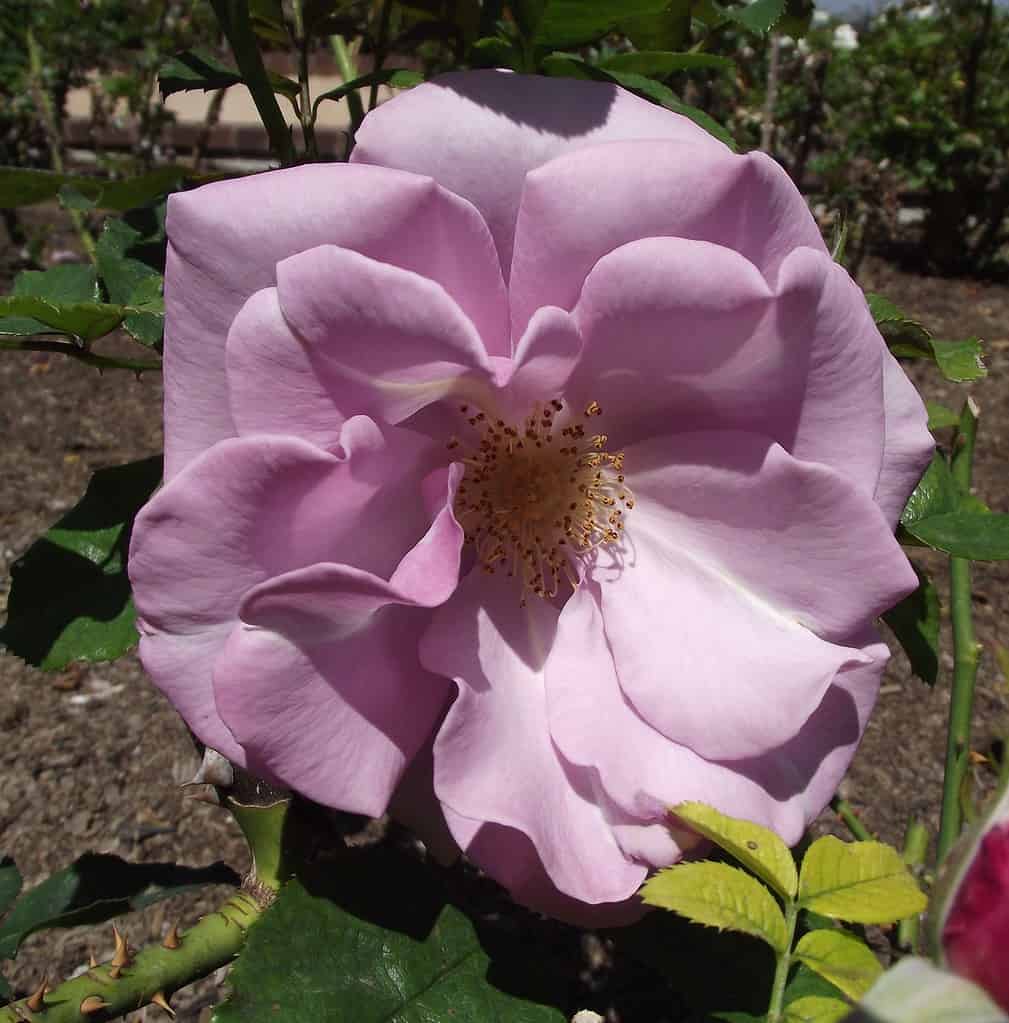Since the blue pigment is not present in roses by nature, a blue rose technically cannot exist in nature. But for rose breeders and enthusiasts, finding blue roses has become something of a holy grail throughout the years. Now that the word “blue” appears in the cultivar names, gardeners may purchase plants with various hues of blue or near-blue.
In this guide, we’ll take a look at everything you need to know about blue roses, as well as a few cultivars and varieties to keep an eye out for.
The History Of The Blue Rose
A blue rose is any type of rose that has a blue or purple hue to it, rather than the common pink, red, or white hues typical of roses. Blue roses have been depicted in art and literature historically. Later, novels and films utilized it as a prop or topic. Blue roses are used to represent mystery or the desire to achieve the unattainable.
Naturally, there is no such thing as a blue rose. According to legend, the first blue rose was a white rose that had been painted or colored blue. In 2004, scientists employed genetic engineering to create roses that are naturally deficient in the bluish dye called delphinidin. It was referred to as a Blue Rose even though the hue was more lilac than blue. Therefore, it is difficult to make a real blue rose.
Blue Rose Legitimacy
Regardless of its legitimacy, the blue rose has its place in history. Tennessee Williams wrote the moving and well-known theatrical drama “The Glass Menagerie” in 1944. One of the characters is Laura, a teenage girl who has pleurosis, a respiratory disease that was more prevalent before antibiotics were widely used. Breathing difficulties are the major sign of pleurosis and they can be quite crippling. When Laura informed a man she had pleurosis in high school, the man she had a long-standing infatuation with misheard her and thought she said “blue flowers.” Because of this, he called Laura by the name Blue Roses.
The idea of the blue rose has captivated people all across the world for more than a century. Horticultural associations from Britain and Belgium offered a reward of 500,000 francs to the person who could develop a pure blue rose as early as 1840. The ability to grow blue roses has long been regarded as a massive potential achievement of horticulturists all around the world.
What Do Blue Roses Mean?
The significance and symbolism of flowers are well recognized. The blue rose symbolizes real love, which is unmatchable and unreachable. Other interpretations of blue flowers include mystery, unrequited love, intense yearning, unfulfilled longing, patriotism, or the birth of a male child. The blue rose represents mystery and a desire to accomplish the impossibly difficult. Some cultures even claim that the owner of a blue rose will have all of his wishes fulfilled. The blue rose is a symbol of unreachable love in Chinese culture.
A rose is one of the most popular flowers to send to a special someone or a loved one. The blue rose is becoming increasingly popular to offer as a gift since it is uncommon and exceptional and shows how precious the receiver is to the giver. The rare blue rose, the ideal valentine’s gift, represents devotion, trust, and love. The Blue Rose is the most uncommon color of rose. Therefore, you can anticipate that the cost of the flower will be more than other hues. When buying a bouquet of these enigmatic flowers, it is essential to get in touch with your florist well in advance because the blue rose is a distinctive, unusual hue.
Do Blue Roses Actually Exist?
Unfortunately, not really. True blue roses from nature don’t exist. There are no true blue roses, only a few lavender-tinted types of garden roses and a few cut rose kinds. You must choose roses that have been dyed, colored, or painted if you want real blue. When that happens, you should put them in a vase or another type of flower arrangement. True blue does not exist in roses when it comes to patio and garden roses.
The gene pool of roses does not contain the color blue. This implies that a blue rose cannot be produced naturally or through rose cross-breeding. You won’t find the hues blue or black in flowers.
So do we have to wait for a rose to be crossed with a flower type whose inherent DNA contains blue? When will this occur? As a genuine, natural blue rose would be the money-making machine for the first inventor, many are presumably working on it.
As we mentioned earlier, in 2004, scientists employed genetic engineering to produce roses that are naturally deficient in the blue pigment delphinidin. It was nevertheless referred to as a blue rose even though the hue turned out to be more of a lilac color. But in reality, it isn’t. A real blue rose cannot be produced at the present time and is not anticipated to be achievable in the future.
That being said, many “blue” varieties out there appear quite blue in appearance but have a more purplish hue to them.

Most blue roses (pictured) do not actually exist in nature and are instead white roses that are dyed blue.
©iStock.com/courtyardpix
Actual Blue Rose Varieties
Blue Girl Rose
Botanical Name: Rosa ‘Blue Girl’
The hybrid tea rose Blue Girl, also known as Cologne Carnival or Koelner Karneval, has big flowers and a light smell. It was developed in Germany and won the 1964 Rome Gold Medal. Although the Blue Girl rose is advertised as “blue,” it has lavender undertones. It is a rose that is frequently seen in plant catalogs and nurseries.
Suntory Blue Rose Applause Rose
Botanical Name: Rosa ‘Applause’
According to Suntory, genetic engineering has produced the first true blue rose. This has come about after many attempts to extract a color-coding gene from various blue flowers, including petunias and pansies, and an enzyme to unlock pigment from irises. Geneticists from Florigene Ltd., an Australian biotechnology company that is part of the Japanese Suntory group of companies, cracked the code to produce a rose that contains nearly 100% blue pigment. Don’t expect to find this rose at your local nursery, though. It’s one of the rarest roses out there.
Blue Nile Rose
Botanical Name: Rosa ‘Blue Nile’
This robust hybrid tea rose named Blue Nile is aptly named, as its hues resemble that of crisp, clean river water. It boasts rich lavender-mauve double blossoms with accents of violet. The notably big, olive-green leaves are covered in fragrant blooms that can be clustered or solitary.
Rhapsody in Blue Rose
Botanical Name: Rosa ‘Rhapsody in Blue’
Frank Cowlishaw created this rose plant in 1999, and it quickly soared to popularity thanks to its iridescent bluish-mauve petals and golden stamens of fully opened blooms. Because it grows tall and bushy, this repeat-flowering shrub is frequently utilized as landscaping borders.

Rhapsody in Blue roses (pictured) is quite striking and popular in the rose gardening world.
©Edita Medeina/Shutterstock.com
Shocking Blue Rose
Botanical Name: Rosa ‘Shocking Blue’
The Shocking Blue rose produces masses of single or clustered blooms that are extremely huge in size over a long period of time, just like all floribundas or free flowering kinds. The deep mauve color of the traditional rose-shaped blooms contrasts nicely with the glossy, dark green foliage. It is frequently used in rose breeding to give other seedlings color. This rose smells strongly of citrus and is richly scented. It has a span of three to four feet and a height of two feet.
Blue for You Rose
Botanical Name: Rosa ‘Blue for You’
This bluish-purple rose bloom, often called Pacific Dream or Honky Tonk Blues has a pink center. The plant, which Peter J. James hybridized in 2006, may reach a height of five feet and is a popular choice for themed gardens.
Blue Moon Rose
Botanical Name: Rosa ‘Blue Moon’
This variety is well-liked since it could be the closest approach to a historically hybridized genuine blue rose on the market. It is a fragrant tea rose shrub that grows well in warm, protected parts of the garden. There is also a climber variety called Blue Moon as well. Grow the Blue Moon rose in direct sunlight next to a wall or fence. In 1964, this plant was awarded the Rome Gold Medal.
Blueberry Hill Rose

©Stickpen, Public domain, via Wikimedia Commons – License
Botanical Name: Rosa ‘Wekcryplag’
The Blueberry Hill rose is a semi-double floribunda rose with enormous, delicate-apple-scented flowers. It offers something a little unusual. The National Gardening Association reports that the blossoms on this rose range from mauve to lavender with blue undertones. Its shape and flower cover resemble an azalea shrub, and it blooms freely all summer. The shrub can reach a height of four feet.
Artificially Dyed Blue Roses
Botanical Name: N/A
Since blue roses are so rare, you won’t find them at your local nursery or grocery store. If you do happen to spot a vibrant blue rose, chances are it isn’t really blue at all. It is more likely a white rose, likely a common variety, that has been artificially colored with blue due. Thus, they won’t produce any new blue flowers, and the cuttings will dye with whatever dye they have.
There are several techniques for turning white roses blue. The most typical one involves adding a unique color to the water. You put water in a glass vase or a plastic container until it is two-thirds full. A few drops of special flower coloring should be added to the vase. The color becomes darker as you add additional food coloring. With a spoon, stir the colored water. Purchase some white roses from a flower store, wholesaler, or garden and use sharp scissors to trim the ends of the rose stems about a half-inch from the end. Cut the bloom at an angle so that it can absorb the liquid more effectively. Place the stems in the vase, add the flowers to the colored water, and let the flowers soak for two days.
How cool are blue roses? While the debate about just how true of a blue these rose varieties are rages on, they are nonetheless aesthetically pleasing. They can add an element of uniqueness to any garden, especially a rose garden. Why not plant some blue roses this year for an extra pop of color?
Summary Of 9 Types Of Stunning Blue Roses
| Rank | Blue Rose |
|---|---|
| 1 | Blue Girl Rose |
| 2 | Suntory Blue Rose Applause Rose |
| 3 | Blue Nile Rose |
| 4 | Rhapsody in Blue Rose |
| 5 | Shocking Blue Rose |
| 6 | Blue for You Rose |
| 7 | Blue Moon Rose |
| 8 | Blueberry Hill Rose |
| 9 | Artificially Dyed Blue Roses |
The photo featured at the top of this post is © iStock.com/Khaneeros
Sources
- NCSU Staff, Available here: https://plants.ces.ncsu.edu/plants/rosa/
- Sheryl Geerts, Available here: https://www.bhg.com/gardening/flowers/roses/ultimate-rose-care-guide/
- Garden Guides Staff, Available here: https://www.gardenguides.com/105292-different-types-blue-rose-flowers.html
FAQs (Frequently Asked Questions)
Do blue roses grow naturally?
No. Blue roses do not occur naturally in the wild. Blue roses are either dyed or genetically engineered.
What is the symbolism behind blue roses?
Blue roses usually symbolize love, especially tragic unrequited love.
How rare are blue roses?
Blue roses are widely considered the rarest type of rose.
Thank you for reading! Have some feedback for us? Contact the AZ Animals editorial team.






